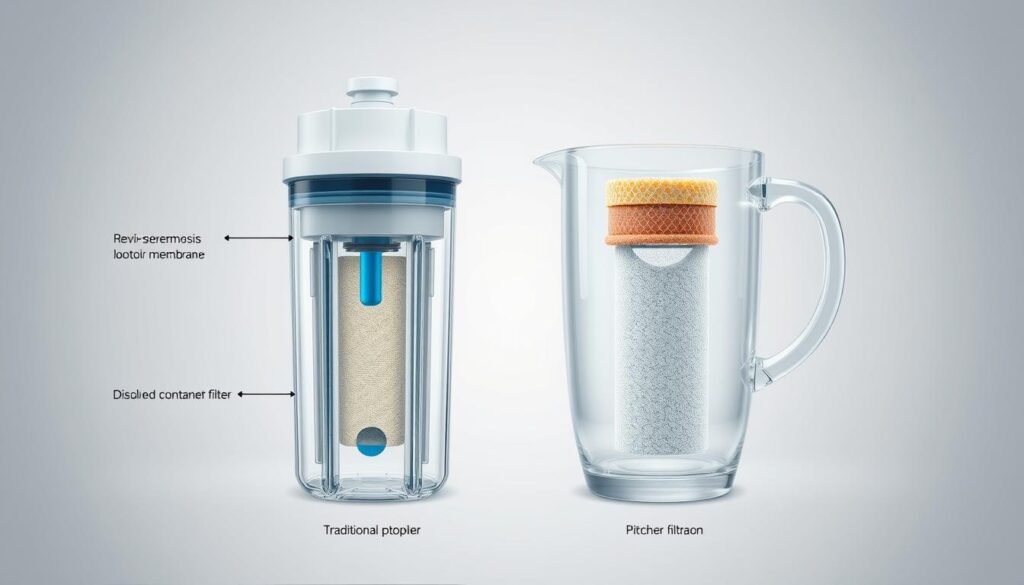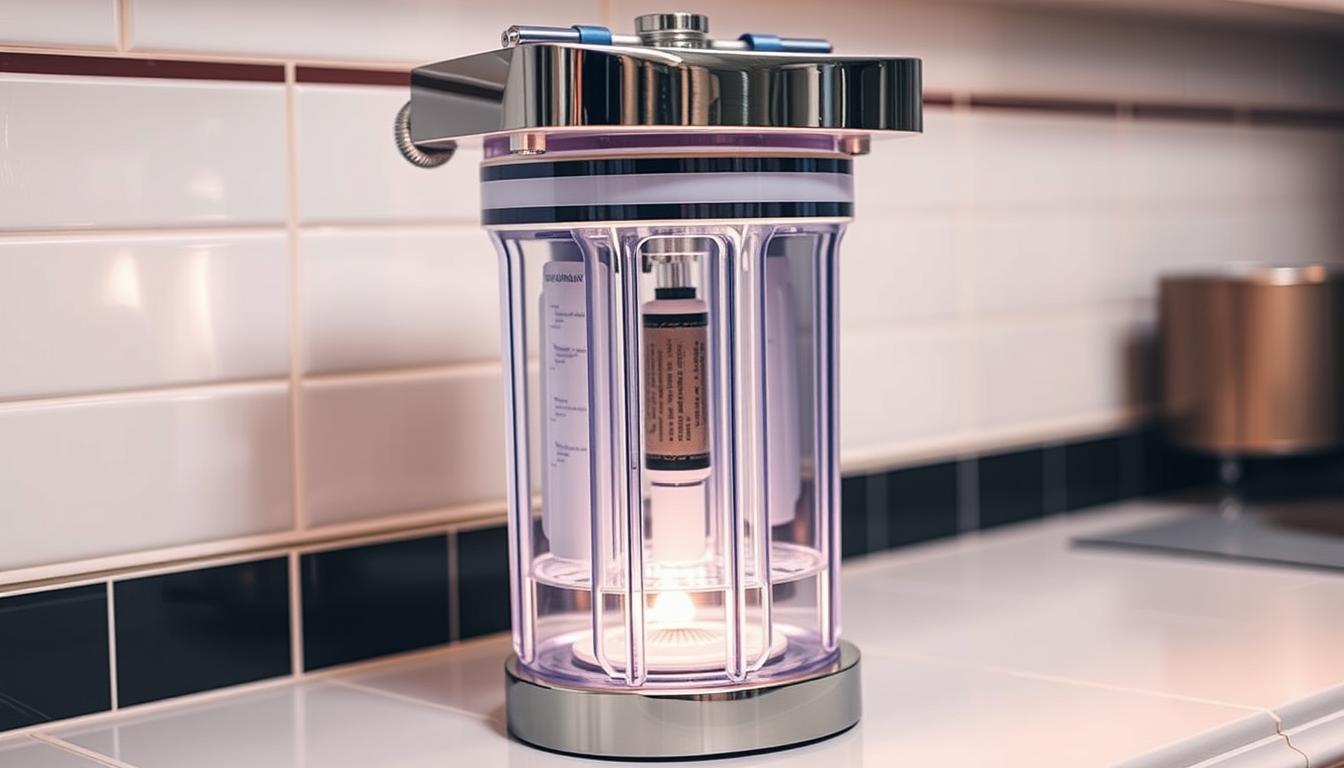Have you ever filled a glass from the tap and wondered what might be hiding in it? Last spring, a neighbor shared their water test results with me. The nitrate levels were nearly twice the EPA’s safety limit – a silent issue many households face without realizing it.
Nitrates often enter our supply through agricultural runoff, aging septic systems, or natural mineral deposits. These compounds become problematic at high concentrations, particularly for families with young children or pregnant members. The challenge? Most standard pitchers and faucet attachments can’t effectively reduce these dissolved contaminants.
This is where advanced solutions like CovePure’s reverse osmosis systems make a difference. Unlike basic carbon filters, RO technology uses semi-permeable membranes to remove up to 99% of nitrates alongside other concerning substances. We’ll explore how this process works, why it outperforms conventional methods, and what homeowners should consider when choosing a system.
Throughout this guide, we’ll break down technical details into practical insights. You’ll learn how contamination occurs, compare filtration effectiveness through real-world data, and discover maintenance tips to keep your household protected. Let’s start by understanding what makes nitrates so persistent – and why they demand specialized treatment.
Understanding the Presence and Risks of Nitrates in Our Water
Many homeowners are unaware that their drinking supply could contain invisible threats. Let’s examine how these compounds enter our homes and why they require specialized attention.
Origins of Nitrate Contamination in Water Sources
Natural mineral deposits release small amounts of nitrates into groundwater. However, human activities dramatically increase concentrations. Fertilizer runoff from farms and leaks from aging septic systems are primary culprits. Industrial processes and wastewater discharge further elevate ppm levels in vulnerable areas.

Rainfall easily transports these compounds into wells and municipal supplies. Once dissolved, they persist through standard treatment methods, making advanced filtration essential for safe tap water.
Health and Chronic Exposure Concerns Backed by Research
A 2021 Environmental Health Perspectives study linked long-term ingestion to thyroid dysfunction and certain cancers. Infants face acute risks – high ppm nitrate exposure can cause methemoglobinemia, limiting oxygen transport in blood.
Vulnerable groups like pregnant individuals require extra caution. Systems like CovePure’s reverse osmosis units address this by reducing contaminants to non-detectable levels. Later sections will compare how different technologies achieve these results, empowering informed decisions for household safety.
The Science Behind Reverse Osmosis Versus Traditional Pitcher Filters
Modern households face a critical decision: which technology truly eliminates harmful substances from their taps? While convenience often drives choices, understanding core scientific principles reveals why some methods outperform others.

How Reverse Osmosis Effectively Removes Contaminants
Reverse osmosis employs a semi-permeable membrane with pores 0.0001 microns wide. This physical barrier blocks dissolved solids, microorganisms, and chemical compounds. Water undergoes three stages:
- Pre-filtration to trap sediment
- Membrane separation removing 90-99% of impurities
- Post-treatment polishing for taste
Independent tests show RO reduces nitrates to below 2 ppm – surpassing EPA guidelines. Unlike basic carbon filters, this process addresses viruses, heavy metals, and pharmaceutical residues simultaneously.
Comparing Reverse Osmosis to Standard Filters
Pitcher-style units primarily use activated carbon to adsorb chlorine and odors. While improving taste, they leave dissolved ions like nitrates untouched. Consider these limitations:
- Effective only against larger particles (5+ microns)
- No reduction of dissolved salts or minerals
- Frequent cartridge replacements required
RO systems provide comprehensive treatment through multi-stage filtration. For homes with elevated contaminant levels, this difference becomes non-negotiable. Our next sections explore specific solutions that leverage this science for reliable protection.
Exploring the Best Water Filter Nitrates: Spotlight on CovePure
When addressing dissolved impurities, not all solutions deliver equal results. CovePure’s reverse osmosis approach combines precision engineering with rigorous validation – a formula that sets new benchmarks in household safety.
How CovePure’s Technology Targets Nitrates and More
The system employs a four-stage purification process designed for maximum contaminant rejection. A specialized membrane with 0.0001-micron pores acts as the primary defense, physically blocking dissolved ions like nitrates. Three additional stages enhance protection:
- Sediment pre-filter traps rust and dirt
- Carbon layer neutralizes chlorine and organic compounds
- Polishing filter improves taste and clarity
Filtering Capabilities: Removing Up to 99.9% of Contaminants
Independent SGS testing confirms CovePure systems exceed NSF/ANSI standards 42, 53, and 58. This validation ensures consistent performance against diverse threats:
- Lead reduction to 0.001 ppm
- 99.6% chlorine elimination
- Bacterial contamination blocked at 99.94% efficiency
For households prioritizing safety, the CP-16 model currently offers substantial savings. Its compact design delivers professional-grade treatment without requiring complex installation. We recommend reviewing certified performance data to understand how these systems transform tap sources into reliably clean drinking supplies.
Key Considerations When Choosing a Reverse Osmosis System
Selecting the right purification setup requires balancing technical specifications with real-world needs. Let’s break down what truly matters for long-term effectiveness and peace of mind.
Features to Look For in a Quality RO System
Prioritize these components when evaluating options:
- Multi-stage filtration (4+ layers) for comprehensive contaminant reduction
- NSF-certified membranes with ≥98% rejection rates
- Clear filter lifespan indicators and easy cartridge replacements
- Leak-proof design with automatic shutoff valves
Durability matters – systems with stainless-steel fittings typically outlast plastic counterparts. Maintenance costs also play a role; calculate annual filter expenses before purchasing.
The Advantage of Security and Performance with Products Tested by SGS
Third-party validation separates marketing claims from measurable results. SGS-tested units undergo rigorous checks for:
- Consistent contaminant removal across varying ppm levels
- Material safety and BPA-free construction
- Flow rate stability under different pressure conditions
CovePure’s CP-16 model demonstrates this commitment, achieving 99.1% nitrate reduction in controlled trials. For a limited time, homeowners can access a $200 discount – making professional-grade protection more accessible than ever.
Always request certified performance data before installation. This step ensures your chosen system addresses specific household concerns, from agricultural runoff to aging infrastructure challenges.
Conclusion
Every family deserves peace of mind about what flows from their faucets. Elevated nitrate levels in tap supplies pose serious health risks, particularly for vulnerable groups. While basic pitchers improve taste, they lack the precision needed to address dissolved contaminants effectively.
Reverse osmosis stands apart through its multi-stage approach. Semi-permeable membranes and advanced filtration layers work together to achieve 99% reduction rates for impurities. This science-backed method outperforms conventional options by addressing microscopic threats standard systems miss.
CovePure’s CP-16 exemplifies modern innovation with SGS-verified performance. Its compact design delivers whole-house protection while maintaining a 1:1 wastewater ratio – a rare efficiency in residential treatment. For a limited time, homeowners can secure this system at $200 off, making premium safety accessible.
Don’t compromise on your household’s well-being. Take action today to upgrade your water treatment strategy with technology proven to meet rigorous standards. Clean, reliable hydration starts with choosing solutions built for results.

Leave a Reply